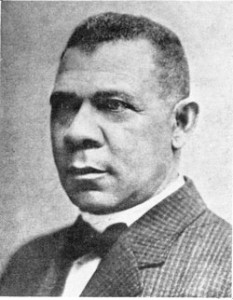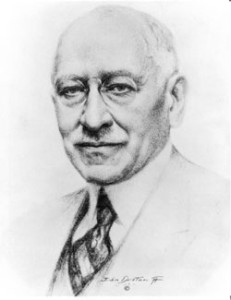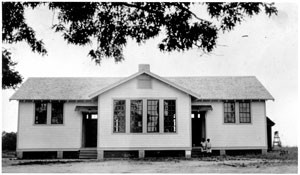ROSENWALD SCHOOL HISTORY
Saving the South’s Rosenwald Schools
by Tom HanchettON A RURAL ROAD in Duplin County, North Carolina, Angelo Franceschina spies the tell-tale bank of windows in the trees off to the right. He coaxes his battered BMW into reverse, backs, and heads up the dirt driveway.
In the Mississippi Delta town of Drew, ninety volunteers pitch in to clean out the building they’ve affectionately nicknamed “Little Red,” abandoned since the 1970s but still beloved in local memory.
At the Noble Hill – Wheeler Museum in Cassville, Georgia, northwest of Atlanta’s suburbs, curator Marian Coleman shepherds a class of 3rd graders toward the row of old desks, letting them touch the cast-iron frames and slide onto oak seats that shine from years of use.
All three are part of a grassroots preservation movement that is rediscovering Rosenwald Schools, one of the more amazing stories in the history of American education.
THE ROSENWALD SCHOOLS blossomed from a problem, and a partnership.
The problem was the sorry state of African American education in the South after 1900. Since slavery times, when most states had flatly forbidden teaching slaves to read, black Americans had hungered for learning. They flocked to academies set up by missionaries after the Civil War, and poured into public schools in the late nineteenth century, often attending in larger numbers than their white counterparts.
The separate schools for blacks were never equal, but things got worse after 1900. That was when Southern states stripped blacks of the right to vote – Disfranchisement it was called. By 1915, public schools in North Carolina, to cite just one example, spent $7.40 per white pupil but only $2.30 per black pupil, compared with the US average of nearly $30.00 per student.

In the 1910s an unlikely partnership took aim at that problem. The idea-man was a black ex-slave in Alabama. Booker T. Washington headed Tuskeegee Institute, which he built into a major black college by convincing Northern philanthropists to aid a hands-on self-help approach he called “industrial education.” Washington thought that self-help and Northern philanthropy might transform public schools as well. In 1913 he found his angel in the person of Julius Rosenwald.
Rosenwald was a white Northerner, a German-Jewish immigrant’s son. Raised in Springfield, Illinois, young Julius had joined a fledgling Chicago concern named Sears, Roebuck and Company in 1897. The next year the United States Post Office instituted Rural Free Delivery of mail. Rosenwald help Sears seize this magnificent selling opportunity, and by 1909 he was CEO of the world’s largest retailer. Hardly a household anywhere in America was without a thick, enticing Sears mail-order catalog.
Rosenwald turned energetically to philanthropy and quickly became known for thoughtful gifts ranging far beyond Chicago. He gave $1000 grants to the first 100 counties to hire County Extension Agents, helping the US Department of Agriculture launch a program that still shapes rural America today. Noting the thousands of African Americans fleeing the South, he helped build almost two dozen black YMCAs to provide lodging and social services in America’s largest cities.

Rosenwald’s religious heritage gave him a particular affinity to African Americans, according to grandson and biographer Dr. Peter Ascoli. Wrote the philanthropist in 1911, “The horrors that are due to race prejudice come home to the Jew more forcefully than to others of the white race, on account of the centuries of persecution which they have suffered and still suffer.”
Booker T. Washington’s vision of rural schools caught Rosenwald’s imagination. Together, the idea-man and the moneyman hammered out an early example of a now-common philanthropic tool: the matching grant. If a rural black community could scrape together a contribution, and if the white school board would agree to operate the facility, Rosenwald would contribute cash – usually about 1/5 of the total project. The aim was quietly radical, a Rosenwald Fund official later wrote; “not merely a series of schoolhouses, but … a community enterprise in cooperation between citizens and officials, white and colored.”
Even Professor W.E.B. DuBois, the great rival of Booker T. Washington, applauded the Rosenwald initiative. DuBois focused his own energies on college education to produce black leaders, but when Julius Rosenwald died in 1932 DuBois penned a lengthy appreciation of the philanthropist’s impact on pre-college opportunities. Interestingly, in the Fund’s waning years after 1932, it ceased its construction grants and instead began giving scholarships to promising black thinkers. Ralph Ellison, to cite one famous example, wrote his searing book The Invisible Man on a Rosenwald Fellowship.
Work-a-day African Americans enthusiastically embraced Rosenwald’s school construction plan — even though it meant considerable sacrifice on top of taxes they were already paying. Cash was scarce in this region where many people farmed “on shares.” To gather nickels a nd dimes, women of a community might hold a “box party,” fixing boxed lunches for neighbors to bid on. Families joined to plant an extra acre of cotton or raise hogs and chickens to be sold for the effort. Blacks who owned land might donate the school site, or cut trees to be sawn into boards for the work crews.
SOON SCHOOLS DOTTED THE SOUTHLAND. By 1932, when the construction grants ended, 5357 new buildings stood in 883 counties throughout fifteen Southern states. Most were schools, but workshops and teachers homes also occasionally received funding. North Carolina boasted 813 Rosenwald-assisted structures, Mississippi had 637, Texas 527, South Carolina 500, Louisiana 435, Alabama 407, Arkansas 389, Virginia 381, Tennessee 373, Georgia 261, Oklahoma 198, Kentucky 158, Maryland 153, Florida 125, and Missouri 4.
The schools came in all sizes from little one-teacher units all the way up to seven-teacher facilities that offered full instruction from first grade through high school. In the program’s early years, wooden two-teacher and three-teacher structures seem to have been most common. By the mid 1920s, brick construction and larger buildings began to appear more often.
Few carried the name “Rosenwald” – Julius discouraged such tributes. The schools did share a certain look, however.
The Rosenwald Fund provided state-of-the-art architectural plans. Two black architecture professors at Tuskeegee, Robert R. Taylor and W.A. Hazel, drew the first set for a 1915 pamphlet The Negro Rural School and Its Relation to the Community. In 1920 Rosenwald official Samuel L. Smith assumed the task. His Community School Plans patternbooks were eventually distributed by the Interstate School Building Service and reached thousands of communities far beyond the South.

Large banks of windows characterized Rosenwald Schools, a simple but powerful innovation in an era when electricity seldom reached into rural areas. Designers carefully specified room size and height, blackboard and desk placement, paint colors and even the arrangements of window shades in order to make best use of natural light. Marshaling the sun’s rays became almost an obsession for S.L. Smith. He insisted windows must be placed so that light came only from the students’ left, and he went so far as to provide different floorplans for schools depending upon which compass direction they faced.
Inside, the buildings almost always included meeting space, a key aspect of Booker T. Washington’s vision. In smaller buildings, a movable partition allowed classrooms to be thrown together as an assembly hall. Bigger schools featured a permanent auditorium. Dr. Washington saw each school as a community center. Rosenwald buildings would not only teach the young, but would help dispersed rural people come together to improve farming techniques and forge a strong community culture. Indeed families often built homes clustered around the schools, creating settlements that persist today.
MARIAN COLEMAN REMEMBERS the Noble Hill School as just such a hub of African American life in Cassville, Georgia. “My dad said they were always having suppers and fundraisers, helping parents who couldn’t afford books for their children, or getting money for coal or wood to heat the school.” Village baseball teams competed on the grounds. “And any type of meeting they’d have to discuss the community, they’d use this building because it was big enough to hold the people.”
The wooden 1923 building looks modest by modern standards, but its two spacious high-ceilinged classrooms and third multi-purpose space made it far superior to the town’s previous black school, a one-room shanty condemned by the authorities.
“A man and his wife were the teachers” for many years, Coleman recalls. “The woman took the first through third graders in one room, the man over the older kids in the other, up to sixth grade.” An instructor’s work in those days did not stop when classes let out. “After school, youngsters knew not to get into fights on the way home – he’d pop out of nowhere to watch them and make sure they got home safe. Everyone in the community looked up to him to help raise the kids.” Indeed, teachers were expected to always be role models and leaders. “There wasn’t much in this town that the teachers were not a big part of.”
The Noble Hill building fell silent in 1955 when several small schools were consolidated into a bigger new facility. But a former student named Dr. Susan Wheeler never forgot the little building, even as she rose to become Curriculum Director in Cassville’s racially integrated school system. She raised dollars from alumni and garnered a grant from Georgia’s State Historic Preservation Office. In 1989 the restored building opened as a museum, winning a Georgia Historic Preservation Trust award.
“Today people use it for meetings, birthday parties, even a wedding,” says curator Coleman. “We have shelters for picnics, family reunions in July and August.” The school system holds orientation for new teachers there each summer, and about half the town’s third-graders visit annually on field trips . “Children are fascinated by the desks, how they sit in rows and don’t move. They are amazed that a school didn’t have a gym or cafeteria, or even indoor bathrooms.”
“I try to teach my kids that looking at the past where you came from will help you plan for the future,” Coleman emphasizes. “I think it’s important for them to know what their parents and grandparents had to go through to get them where they are today.”
RESTORED ROSENWALDS are a rarity, unfortunately. More typical is the state of “Little Red” out on highway 49 at the edge of Drew, Mississippi. This is still the poor rural South, a town of barely 3000 people, many of whom work at the Parchman Farm prison seven miles away. The red-brick Rosenwald school has stood vacant and open to the weather for over two decades.
Just recently a pair of young faculty members — Luther Brown from Delta State University and Susan Glisson from University of Mississippi — teamed with local minister Rev. Jesse Gresham to write a $382,000 state grant to begin renovation. On September 22, 2001, ninety people pitched in for a day-long cleanup effort, shoveling out mounds of water-soaked textbooks and fallen ceiling tiles.
For Rev. Gresham, the group effort meant an opportunity to begin mending a hole in the city’s soul that dates back a generation. When the Civil Rights Movement won blacks the right to attend integrated schools, whites often retaliated by abandoning buildings in African American neighborhoods. “People had loved that school. When the school board said it was going to be abandoned, that made people angry,” Gresham says. Today the hurt is at last fading, as white leaders join forces with blacks to win renovation funds.
D. Allen “Chip” Mitchell, a wh ite twenty-six year old who took part in the clean-up, points out that many helpers were teens too young to remember Little Red’s glory days. “I pondered the motivation for a youngster to give up a Saturday doing such hard and dirty work,” he muses. “Then it hit me. You see, this will be their community center, a place where they can come after school and on weekends. It was an honor and a privilege for me to sweat off a couple of pounds in a tiny contribution to their efforts.”
“The tragedies in New York had left me feeling particularly helpless but the Drew project reminded me of this country’s greatness,” adds Mitchell. “America’s strength lies in the persistence of its children, their parents and their community leaders in making a dream come true.”
That dream is still far from realization, though, even with the clean up and the grant. Funds on hand will allow renovation of the original five-teacher Rosenwald structure, but right now plans call for simply mothballing the wings that were added over the years. Years of broken windows and leaking roofs mean that several hundred thousand dollars more must be found. Only then will Little Red fully come back to life.
ANGELO FRANCESCHINA IS LOOKING for ways to help schools like Little Red.
A carpenter and community organizer by training, he was running a nonprofit Community Development Corporation in Indianapolis when his wife found an attractive job with an airline in Winston Salem, North Carolina. Angelo moved.
Soon he started hearing about a group in rural Walnut Cove trying to fix up a derelict building in their midst. “Dorothy Dalton brought me down and wouldn’t let me leave,” he chuckles. “I didn’t know anything about Rosenwald Schools. It just looked like a big old house to me, windows broken out and drug users inside.”
Dalton wheedled Franceschina into putting his community organizing skills to work, stringing together dozens of sources of aid. Alumni purchased memberships and held stew sales. The North Carolina Division of Aging gave $70,000, local foundations led by Z. Smith Reynolds and the Bryan Family provided smaller sums, and the International Brotherhood of Electrical Workers contributed $50,000 of wiring work. The most unexpected help? “The Dan River Prison Work Farm sent inmate crews to do carpentry and painting, Franceschina says appreciatively. “You had to watch them close, but they did good work.”
In 2000 National Trust for Historic Preservation awarded the restored facility, now a senior citizens center, a prestigious Preservation Honor Award. This “successful renovation demonstrates that a community treasure can come full circle,” said Trust president Richard Moe. “Walnut Cove Colored School is truly an inspiration to rural towns across the nation.”
Today Franceschina is living Moe’s words. This gruff-talking midwesterner is stumping the Tar Heel state, helping communities turn under-used schools into success stories. Sometimes he discovers buildings whose history has been lost, like that one-room school in the trees in Duplin County. Often he connects a fledgling group to others who’ve traveled the same path. He can tell you about Central School in Asheboro, renovated for senior citizens’ housing thanks to local leader Addie Luther. Or about the Rosenwald School in Fairmont, whose politically powerful alumni now include several Council members and the Mayor. Or about Alethea Williams King who saved the school her father helped construct; she now sits on Washington County’s heritage tourism board. Or about Nyoni Collins at Wake Forest’s DuBois Rosenwald School, who in 2001 put together one of the South’s first statewide gatherings of Rosenwald activists.
THE NATIONAL TRUST is now harnessing this grassroots energy. The Trust named all the South’s Rosenwald Schools to its “Eleven Most Endangered” list for 2002, putting this preservation challenge in the national spotlight.
In February 2002 the Trust convened activists from all over the South at the Levine Museum of the New South in Charlotte to launch “The Rosenwald Initiative.” Jeane Cyriaque presented results from a school-locating effort underway through Georgia’s Department of Natural Resources. Dorothy Walker of the Alabama Historical Commission shared a carefully researched National Register of Historic Places “context statement” being used to list Rosenwalds throughout her state. Professors Alicestyne Adams of Georgetown College in Kentucky and Mary Hoffschwelle of Middle Tennessee State spoke of scholarly research underway.
Rosenwald Initiative coordinator John Hildreth of the Trust’s Southeast Regional Office says that plans are afoot for a website, plus a major conference in Nashville, Tennessee. The group aims to spread the word about Rosenwald school history, help local communities identify buildings, and encourage the sharing of preservation strategies.
“Out of 5300 Rosenwald schools, we still only know the fate of a few dozen,” Hildreth urges. “The Trust is eager to help address this preservation challenge. These buildings represent an important part of America’s heritage.”
 Recommended additional reading:
Recommended additional reading:
James Anderson, The Education of Blacks in the South, 1860 – 1935(Chapel Hill: University of North Carolina Press, 1988).
Peter Max Ascoli, Julius Rosenwald: The Man Who Build Sears, Roebuck and Advance the Cause of Black Education in the American South (Indiana University Press, 2006).
Stephanie Deutsch, You Need a Schoolhouse: Booker T. Washington, Julius Rosenwald, and the Building of Schools for the Segregated South (Northwestern University Press, 2011).
Edwin Embree and Julia Waxman,Investment in People: The Story of the Julius Rosenwald Fund (New York: Harper and Brothers, 1949).
Adam Fairclough, Teaching Equality: Black Schools in the Age of Jim Crow(Athens: University of Georgia, 2001).
Thomas W. Hanchett, “The Rosenwald Schools and Black Education in North Carolina“, North Carolina Historical Review LXV: 4 (October 1988).
Louis Harlan, Separate and Unequal: Public School Campaigns and Racism in the South States, 1901 – 1915(Chapel Hill: University of North Carolina Press, 1958).
Mary S. Hoffschwelle, The Rosenwald Schools of the American South.(University Press of Florida, 2006).
Mary S. Hoffschwelle, Rebuilding the Rural Southern Community: Reformers, Schools and Homes in Tennessee, 1900 – 1930 (Knoxville: University of Tennessee Press, 1998).
James LeLoudis, Schooling the New South: Pedagogy, Self and Society in North Carolina, 1880 – 1920 (Chapel Hill: University of North Carolina Press, 1996).
Alice Brown Smith, Forgotten Foundations: The Role of Jeanes Teachers in Black Education (New York: Vantage Press, 1997).
S. L. Smith, Builders of Goodwill : The Story of the State Agents of Negro Education in the South, 1910 to 1950(Nashville: Tennessee Book Company, 1950).
Alicestyne Turley-Adams, Rosenwald Schools in Kentucky, 1917 – 1932(Frankfort: Kentucky Heritage Council and the Kentucky African American Heritage Commission, 1997).
Vanessa Siddle Walker, Their Highest Potential: An African American School Community in the Segregated South(Chapel Hill: University of North Carolina Press, 1996).
M. R. Werner, Julius Rosenwald: The Life of a Practical Humanitarian (New York: Harper & Brothers, 1939).
